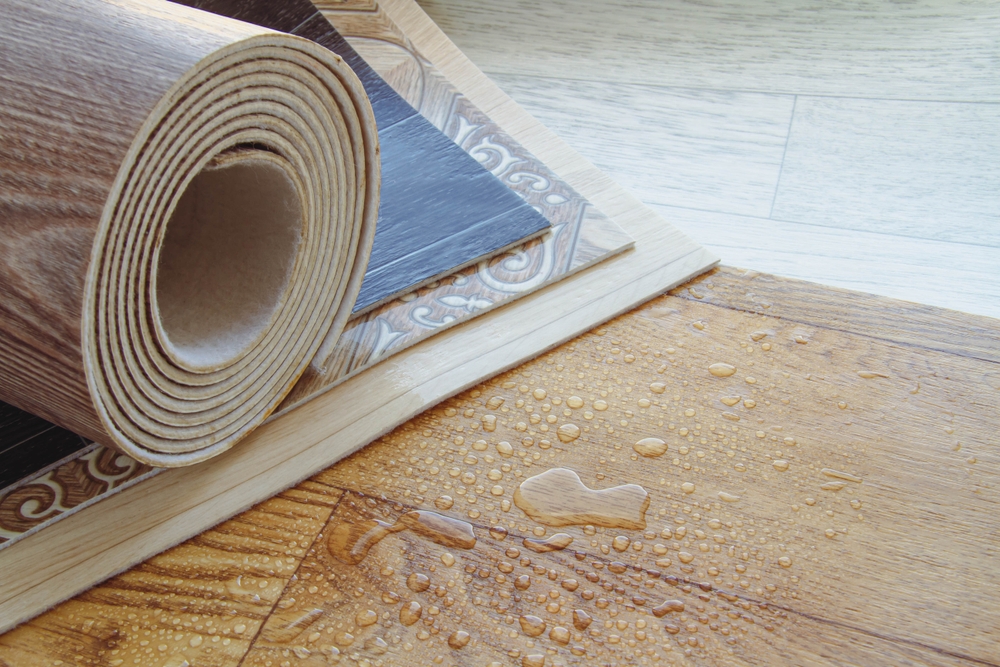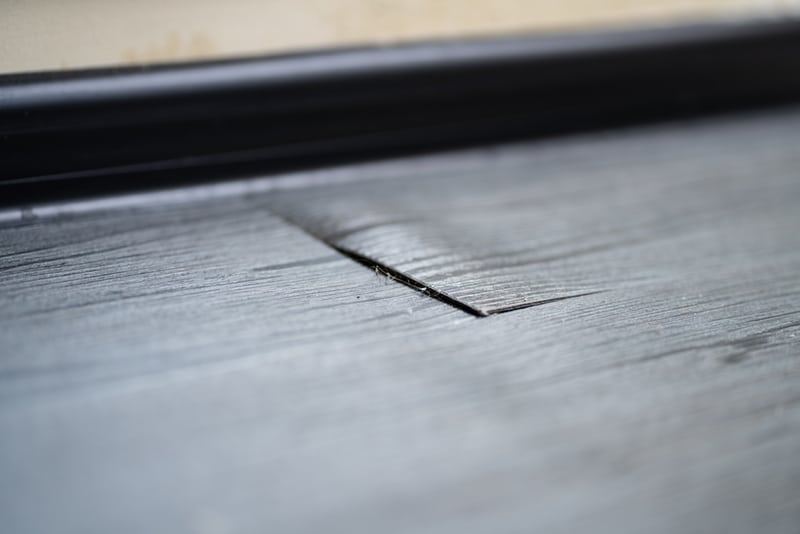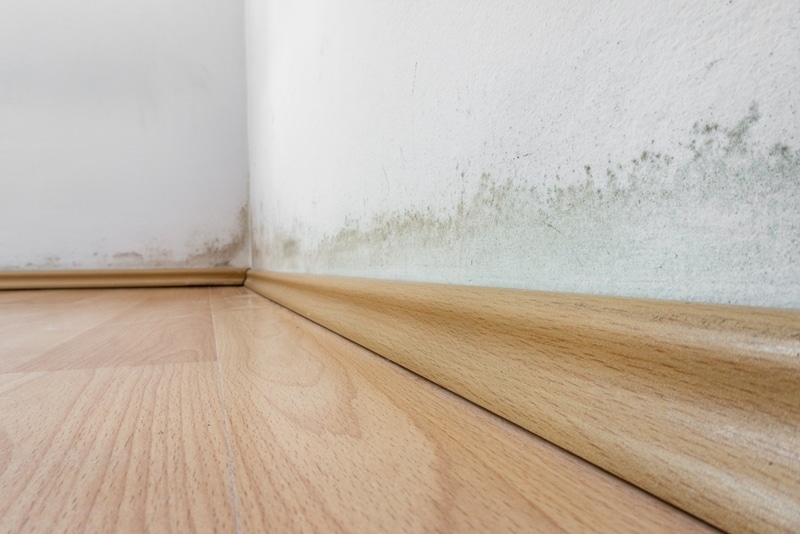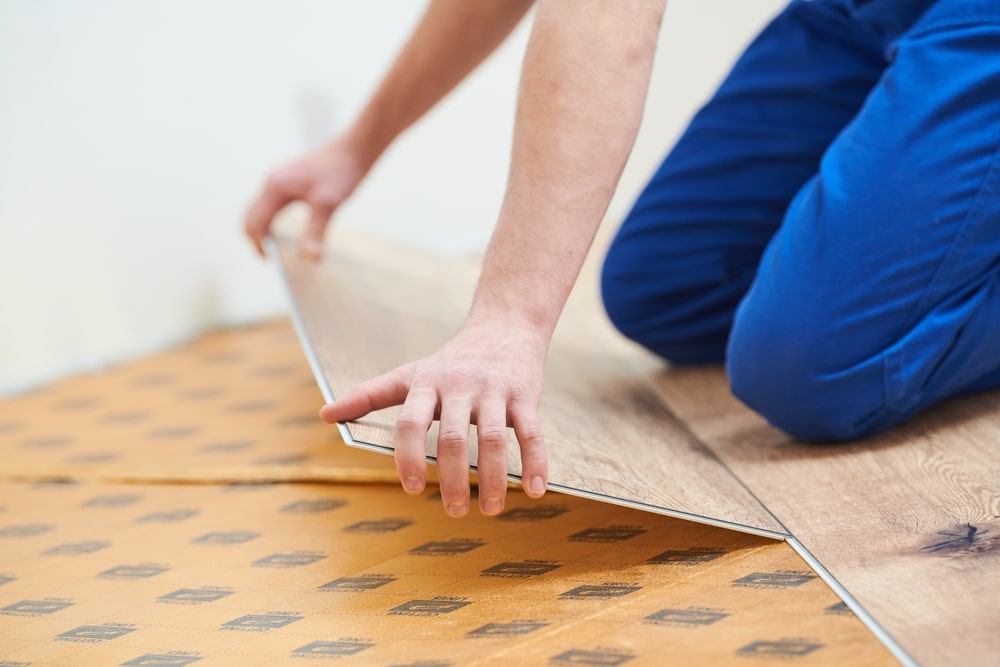Vinyl flooring is a popular choice for Boise homeowners because of its stylish, durable, and waterproof reputation. While vinyl holds up well to everyday spills and mopping, a common misconception is that it can’t be damaged by water. However, water that seeps underneath the planks can cause serious hidden problems.
Knowing how to spot early warning signs of water under vinyl flooring can save you time, money, and stress. In this guide, we’ll walk through why water gets trapped, the signs of damage, the risks of ignoring it, and the best steps to take if you notice a problem.
Table of Contents
Why Water Under Vinyl Floors Happens
Because vinyl is built to resist water on the surface, many homeowners don’t worry about small leaks or damp spots. However, once water seeps underneath, it can’t evaporate on its own, so it creates the perfect conditions for damage and mold.
Here are some of the most frequent causes of water under vinyl plank flooring:
- Flooding or Overflows – Broken appliances, burst pipes, or heavy rain push large amounts of water across your floors, quickly seeping beneath the vinyl.
- Improper Installation – If the subfloor has gaps or isn’t sealed properly, moisture can slip through weak spots and collect underneath.
- Spills That Sit Too Long – Everyday spills may seem harmless, but if not wiped up quickly, the liquid can seep into seams and edges.
- Chemical Exposure – Harsh cleaning products or chemicals can weaken adhesives and protective layers, making it easier for water to penetrate beneath the planks.
Common Signs of Water Damage Under Vinyl Flooring
Vinyl flooring water damage often hides in plain sight. The top layer may look fine, but subtle changes in texture, color, or smell can point to more serious problems below. Here’s what to watch for:
1. Buckling or Warping
When vinyl planks or tiles start to lift, curve, or push upward, it’s a clear sign that moisture has seeped underneath. The subfloor swells as it absorbs water, causing pressure that makes the vinyl bend. This affects the aesthetics of your flooring and poses tripping hazards.
2. Gapping Floor Planks
If you notice gaps forming between your vinyl planks, water may be shifting the subfloor or weakening the adhesive. Floors that once fit tightly together can start pulling apart, leaving seams where dirt and more moisture can collect.
3. Discoloration
Trapped moisture can cause discoloration on the vinyl, such as fading, staining, or a cloudy appearance. This affects the look of your flooring and can be difficult to remove.
4. Mold Growth
Water under vinyl flooring creates the ideal environment for mold growth. If you notice green, black, or white spots along the seams or detect a musty odor, seek certified mold remediation right away. Mold can pose serious health risks and compromise indoor air quality.
5. Bubbles or Blisters
A buildup of water beneath vinyl can cause air pockets to form and bubble. This often happens when water breaks down the adhesive holding the planks in place. If your floor feels spongy when you walk on it, you likely have vinyl flooring water damage.
Health & Structural Risks
When water gets trapped under vinyl flooring, it poses a serious risk to your safety and that of your home. If left untreated, a small flooring issue can become a health hazard or an expensive repair.
The most common risks include:
- Mold Growth – Moisture under floors creates the perfect place for mold to grow. Mold can spread quickly and may trigger allergies, asthma, or breathing problems.
- Air Quality Concerns – As mold and mildew build up, they release spores into the air. This can lower the air quality in your home and make it harder to breathe, especially for children, seniors, or anyone with health conditions.
- Rot or Subfloor Warping – Water damage weakens the wood or other materials under your vinyl. A weakened subfloor is costly to fix and can make your home unsafe.
What To Do: Mitigation & Repair
Do you suspect trapped moisture in your floors? Here’s how to dry up water under vinyl flooring:
- Stop the Source of Water
- Shut off the main water supply if a pipe has burst.
- Fix leaking appliances or plumbing before tackling the floor itself.
- Assess the Extent of the Damage
- Walk across the vinyl and note areas that feel spongy, raised, or discolored.
- Check for musty odors or visible mold along seams.
- Dry the Area Thoroughly
- Small surface spills can be cleaned and dried with towels or fans.
- For larger leaks, you will need professional drying equipment to remove moisture from the subfloor.
- Repair or Replace Flooring
- In minor cases, affected planks can be removed, dried, and reinstalled.
- In severe cases, both vinyl and subfloor materials may need replacement to prevent recurring issues.
- Restore and Prevent Future Damage
- Use proper underlayment and vapor barriers during reinstallation.
- Schedule inspections if you suspect ongoing issues.
While DIY methods can help with surface spills, they usually aren’t enough for hidden water damage. Trapped moisture under the flooring often requires professional water damage services.
Read More: 7 Steps on How to Dry Wet Carpet After a Flood
How to Prevent Water Damage Under Vinyl Flooring
Preventing water damage under vinyl flooring starts with proper installation, regular inspections, and prompt action after spills and leaks. These simple precautions can make your flooring last longer and save you from costly repairs.
- Ensure Proper Installation – Hire qualified installers who seal seams correctly and leave room for expansion. Poor installation is one of the largest causes of trapped moisture.
- Inspect Regularly – Check around sinks, dishwashers, refrigerators, and washing machines for leaks. Small drips can lead to hidden damage if ignored.
- Clean Spills Quickly – Even though vinyl is water-resistant, prolonged exposure to standing water increases the chance of seepage.
- Control Indoor Humidity – Use dehumidifiers in crawl spaces, basements, or tightly sealed homes to prevent moisture from rising into floors.
When To Call The Professionals
DIY drying can handle small surface spills, but some situations require expert attention. You should call a professional restoration team if you notice:
- Mold growth, musty odors, or recurring dampness
- Floors that feel spongy or unsafe to walk on
- Significant warping, buckling, or discoloration
- Water damage across multiple rooms
- Previous attempts to dry the floor haven’t solved the issue
When these warning signs show up, Cleanup & Total Restoration uses powerful drying equipment and moisture meters to find and remove the water source and prevent future issues.
Frequently Asked Questions
Is Vinyl Flooring Waterproof?
The short answer is yes, but that doesn’t make vinyl flooring indestructible. Vinyl flooring is still a great option for areas that may see some water like bathrooms and kitchens due to their water-resistant properties. However, water damage can also get under vinyl flooring, creating problems that may go undetected for long periods.
Will Water Dry Out Under Vinyl Flooring On It’s Own?
If water or excess moisture is under your vinyl flooring, it is not likely to dry up on its own without leaving damage. Excess moisture and water under the flooring can deteriorate and soften vinyl planks. Addressing surface-level moisture as well as any water damage under vinyl floors is essential to avoiding a worsening situation.
Can Mold Grow Under Vinyl Flooring?
Not only can mold grow under your vinyl flooring, but it can also do so quickly. Mold can grow on surfaces in as little as 24 hours. All it needs is water, warmth, oxygen, and a food source—all of which are available under your water-damaged floors.
Read More: How to Repair Water Damage on Drywall & Ceilings
Contact CTR for Professional Floor Water Damage Repair
Water under vinyl flooring can be easy to miss and hard to fix without the right help. It’s normal to worry about the cost of repairs or the time it might take.
At Cleanup & Total Restoration, we understand your concerns. That’s why we make the process as quick, clear, and stress-free as possible with 24/7 floor water damage repair.
Whether you’re dealing with a leak, warped planks, or mold concerns, we provide:
- No Hidden Fees
- 24/7 Emergency Response in Boise and Nearby Areas
- Rapid Arrival — 60 Minutes or Less
- Certified Specialists in Water, Fire, and Storm Damage
If you see the warning signs of water under floorboards, don’t wait until the damage spreads. Call us today for immediate service or request your free estimate online.[/vc_column_text][/vc_column][/vc_row]












